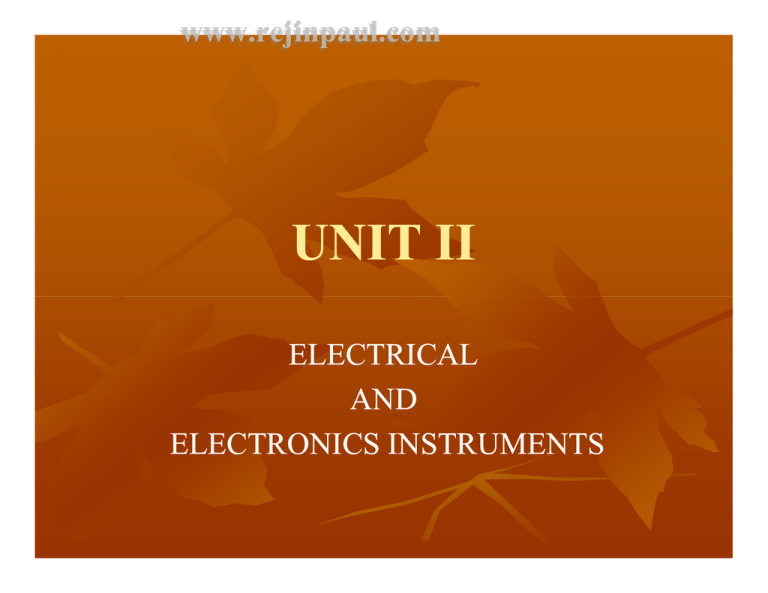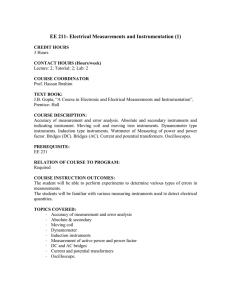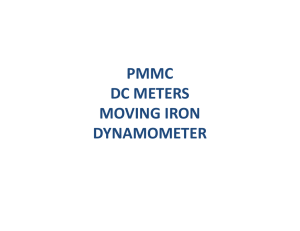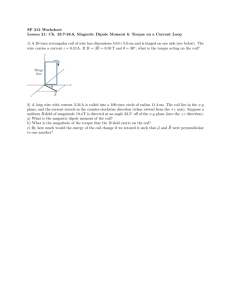measuring instruments
advertisement

www.rejinpaul.com m o UNIT II c . l u a p n i j e r . w w w ELECTRICAL AND ELECTRONICS INSTRUMENTS www.rejinpaul.com MEASURING INSTRUMENTS instruments which is used for measurement Necessary requirements of measurement Circuit condition and the quantity to be measured should not be altered, if measuring circuit is connected. Power consumption by instrument for their operation should be small m o c . l u a p n i j e r . w w w www.rejinpaul.com Instruments used for measure m o c . l u a p n i j e r . w w w Voltage – voltmeter Current – ammeter Power - wattmeter www.rejinpaul.com CLASSIFICATION OF MEASURING INSTRUMENTS Indicating instruments Recording instruments Integrating instruments m o c . l u a p n i j e r . w w w Indicating instruments: Instruments used for indicating or pointing the unknown quantity with the help of pointer or dial. example: voltmeter, ammeter, etc., www.rejinpaul.com Recording instruments: m o c . l u a p n i j e r . w w w It gives a continuous record of electrical quantity to be measured over a specific period. Examples: XYXY- plotter Readings are recorded by drawing graph. Pointer of such instrument is provided with pen or pencil www.rejinpaul.com INTEGRATING INSTRUMENTS to measure the total quantity of electricity delivered over a period of time. Example: energy meter It consists of dials and pointers Counting mechanism registers number of revolutions made by the disc to measure the total quantity of electricity delivered m o c . l u a p n i j e r . w w w www.rejinpaul.com Essential requirements of indicating instrument Deflecting system should produce deflecting torque; Td Controlling system should produce controlling torque; Tc Damping system should produce damping torque; m o c . l u a p n i j e r . w w w www.rejinpaul.com TYPES OF INSTRUMENTS Permanent magnet moving coil (PMMC) Moving iron Electro – dynamometer Hot wire Thermo couple Induction Electro static Rectifier m o c . l u a p n i j e r . w w w www.rejinpaul.com PMMC Most accurate type for dc measurements Principle: When a current carrying conductor is placed in the magnetic field produced by the permanent magnet , coil experiences a force and moves. As the coil is moving and the magnet is permanent, this instrument is called as permanent magnet moving coil instrument. This principle is called as D’ Arsonal principle force experienced is proportional to the current flowing in coil. m o c . l u a p n i j e r . w w w www.rejinpaul.com PMMC construction It consists of m o c . l u a p n i j e r . w w w Moving coil Magnet systems Control damping Pointer and scale www.rejinpaul.com PMMC INSTRUMENT m o c . l u a p n i j e r . w w w www.rejinpaul.com MOVING COIL: Many number of turns of fine wire either rectangular or circular in shape Moves freely in the field of permanent magnet m o c . l u a p n i j e r . w w w Magnet systems Control: Controlling torque is provided by two phosphor bronze hair springs www.rejinpaul.com Damping Damping torque is produced by the aluminium former moving in the magnetic field of the permanent magnet. Pointer and scale: Carried by spindle over a graduated linear scale Light eight so that it deflect rapidly Mirror is placed below the pointer to reduce to get accurate reading to remove parallax error. m o c . l u a p n i j e r . w w w www.rejinpaul.com TORQUE EQUATION Let B = flux density in air gap N = no of turns in the coil L= active length of coil in meters d = average width of coil in meters I= coil current F = force in newton force acting on one side of coil =F ie F = BILN newton m o c . l u a p n i j e r . w w w www.rejinpaul.com Deflecting Torque Td = Force X radius X 2 = BILN d/2 X 2 taking account force on both sides = BI . L N d Nm put L X d = area A then Td -= NBAI Nm Control torque Tc = some constant X 0. m o c . l u a p n i j e r . w w w the constant depends on qualities of the spring. under steady – state condition Tc = Td Therefore is proportional to I (BAN are Constants) www.rejinpaul.com m o c . l u a p n i j e r . w w w www.rejinpaul.com ADVANTAGES OF PMMC INSTRUMENTS linear scale Low power consumption High accuracy Torque to weight ratio is high Single instrument may be used for different ranges Errors due to stray magnetic fields are small m o c . l u a p n i j e r . w w w www.rejinpaul.com DISADVANTAGES OF PMMC INSTRUMENTS Instruments are used only for dc Higher cost compared moving iron instruments m o c . l u a p n i j e r . w w w www.rejinpaul.com Errors in PMMC instruments Basic sources of errors in instruments are Weakening of permanent magnets due to ageing and temperature effects Weakening of springs due to ageing and temperature effects Change of resistance of the moving coil with temperature. m o c . l u a p n i j e r . w w w www.rejinpaul.com MOVING IRON INSTUMENTS Use at power frequencies Used to measure current and voltage accurately m o c . l u a p n i j e r . w w w There are two types of moving iron instruments Attraction type Repulsion type www.rejinpaul.com Attraction type moving iron instrument m o c . l u a p n i j e r . w w w www.rejinpaul.com Construction of moving iron attraction type instruments It consists of Moving iron Scale Piston Coil winding Air damping chamber Pointer Balance weight Control weight m o c . l u a p n i j e r . w w w www.rejinpaul.com Attraction type moving iron instrument Torque equation: m o c . l u a p n i j e r . w w w Force pulling the soft iron piece inward depends on H, magnetic field strength produced by the coil. m , magnetic pole strength of the soft iron piece however m depends on H, magnetic field strength of the coil So force , F α mH α H2 And deflection torque Td α F α H2 Since H depends on current , Td α I2 www.rejinpaul.com When spring control is used, m o c . l u a p n i j e r . w w w Control torque α angular displacement Thus Td α θ At steady state deflection ,Td = Tc i.e.., I2 α θ Or θ α I2 Deflection α (rms value)2 www.rejinpaul.com REPLUSION TYPE MI m o c . l u a p n i j e r . w w w www.rejinpaul.com m o c . l u a p n i j e r . w w w www.rejinpaul.com m o c . l u a p n i j e r . w w w Comparison between attraction type and repulsion type: Attraction type Repulsion type Lower inductance Higher inductance Accurate over wide range of frequency Greater possibility of using shunt less Accurate over wide range of frequency Economical in nature, lesser possibility of using shunt www.rejinpaul.com ADVANTAGES OF MOVING IRON INSTRUMENTS It can be used for d.c and a.c(universal use) Less friction errors Low cost High deflecting torque Accuracy Simple in construction m o c . l u a p n i j e r . w w w www.rejinpaul.com DISADVANTAGES OF MOVING IRON INSTRUMENTS Scales are not uniform Power consumption is high at low voltage measurements Stiffness of spring decreases with rise in temperature Errors are introduced due to Hysteresis and magnetic fields Changes in supply frequency cause serious errors in reading m o c . l u a p n i j e r . w w w www.rejinpaul.com ERRORS IN MOVING IRON INSTRUMENTS The causes of errors in MI may be divided as (I) Errors when used in a.c only (ii) Errors when used in both a.c and dc m o c . l u a p n i j e r . w w w Errors in a.c only 1 Change in impedance of coil 2. Change in eddy current magnitudes www.rejinpaul.com ELECTRO DYNAMOMETER INSTRUMENT Used as voltmeters and ammeters at power frequencies Capable of service as transfer instrument device Principle: m o c . l u a p n i j e r . w w w www.rejinpaul.com CONSTRUCTION OF ELECTRO DYNAMOMETER INSTRUMENT Fixed coils Moving coil Control Moving system Damping Shielding Cases and scales m o c . l u a p n i j e r . w w w www.rejinpaul.com ELECTRO DYNAMOMETER INSTRUMENT m o c . l u a p n i j e r . w w w www.rejinpaul.com Torque equation of electro dynamometer instruments Let I1= instantaneous value of current in the fixed coils ;A I2 = instantaneous value of current in the moving coils; m o c . l u a p n i j e r . w w w Force or torque on a moving system α flux x current Air gap flux is directly related to I1 since fixed coil is air cored. Then deflecting torque Td α I1 I2 in voltmeter I1 = I2 = I say θ α I2 In ammeter, θ α I1 I2 www.rejinpaul.com Advantages of electro dynamometer instruments Free from hysterisis and eddy current errors Accuracy Used for both a.c and d.c m o c . l u a p n i j e r . w w w www.rejinpaul.com Disadvantages of electro dynamometer instruments Low torque/weight ratio Low sensitivity Increased frictional losses More expensive than PMMC Sensitive to overloads and mechanical impact Non uniform scale m o c . l u a p n i j e r . w w w www.rejinpaul.com INSTRUMENT TRANSFORMERS transformers used in conjunction with the measuring instrument for measurement purpose are called instrument transformers. Transformers used for measuring current are called current transformers. Transformers used for measuring voltage are called potential transformers. m o c . l u a p n i j e r . w w w www.rejinpaul.com CURRENT AND POTENTIAL TRANSFORMER m o c . l u a p n i j e r . w w w www.rejinpaul.com m o c . l u a p n i j e r . w w w www.rejinpaul.com Advantages The readings do not depend upon the values of (R,L,C) and also number of instruments connected in the circuit. Very cheap moderate rating can be used for measurement of high voltages and current. Replacement of these transformers are very easy Measuring circuit is isolated from the power circuit Low power consumption m o c . l u a p n i j e r . w w w www.rejinpaul.com Ratios of current transformers Transformation ratio: It is the ratio of the magnitude of the primary phasor to the secondary phasor. R = primary phasor/secondary phasor For C.T , R = primary winding current/secondary winding current For P.T, R = primary winding voltage/secondary winding voltage m o c . l u a p n i j e r . w w w www.rejinpaul.com Nominal ratio It is the ratio of the rated primary winding current (or voltage) to the rated secondary winding current (or voltage). For C.T , Nominal ratio Kn = rated primary winding current / rated secondary winding current For P.T, Nominal ratio Kn = rated primary winding voltage/ rated secondary winding voltage m o c . l u a p n i j e r . w w w www.rejinpaul.com Turns ratio Turns ratio for C.T, n = number of turns of secondary winding/number of turns of primary winding. Turns ratio for P.T, n = number of turns of winding primary /number of turns of secondary winding. Ratio correction factor: The ratio of correction factor is the transformation ratio divided by nominal ratio. transformation ratio = ratio correction factor x nominal ratio m o c . l u a p n i j e r . w w w www.rejinpaul.com Current transformers Connected in series with line current to be measured. Primary winding consists of very few turns and no appreciable voltage drop. Secondary winding has large no. of turns Ammeter or wattmeter directly connected across the secondary winding. One of the secondary terminals earthed for protection of equipment and insulation breakdown in the auto transformer. m o c . l u a p n i j e r . w w w www.rejinpaul.com Construction of current transformers Classification m o c . l u a p n i j e r . w w w Wound type Bar type www.rejinpaul.com Effect of secondary open circuit If secondary is open circuited, Large voltage is induced in the secondary winding It is dangerous to the transformer insulation and the person who has opened Eddy current and hysterisis losses are more due to that transformer overheated and damaged. If not core become permanently magnetized and this m o c . l u a p n i j e r . w w w Will give appreciable ratio and phase angle errors. www.rejinpaul.com Potential transformers Primary winding is connected across the line carrying voltage to be measured. Voltage circuit is connected across the secondary winding Normal secondary voltage rating is 120 V. m o c . l u a p n i j e r . w w w www.rejinpaul.com Difference between C.T and P.T POTENTIAL TRANSFORMER CURRENT TRANSFORMER m o c . l u a p n i j e r . w w w Parallel transformer, operating under nearly open circuit condition Series transformer, operating under Virtual short circuit condition Primary winding current in C.T is independent of secondary circuit condition. Exciting current varies in restricted range. Primary winding current in P.T is dependent of secondary circuit burden Exciting current varies over wide limit range under norma operation. www.rejinpaul.com CONSTRUCTION OF P.T It consists of Core Windings Insulation Bushings m o c . l u a p n i j e r . w w w www.rejinpaul.com m o c . l u a p n i j e r . w w w www.rejinpaul.com High voltage P.T Recently Potential transformer are designed which has resulted In considerable reduction and cost of transformers. Two designs developed to eliminate high voltage lead in bushings . Bushing elimination leads reduction in size and cost of transformers. These designs are intended to measure line to ground voltages in three phase system. These desgns employ: Insulated casing Moulded rubber potential transformer Cascaded transformer m o c . l u a p n i j e r . w w w www.rejinpaul.com m o c . l u a p n i j e r . w w w www.rejinpaul.com Measurement of frequency and phase Types of frequency meters: Mechanical or resonant type Electrical or resonant type Electrodynamometer type Weston type Ratio meter type Saturable core type m o c . l u a p n i j e r . w w w www.rejinpaul.com Mechanical resonant type frequency meter (vibrating reed type) Consists of number of thin metal strips called reeds. When the frequency meter is connected across the supply, whose frequency is to be measured, the coil of electromagnet carries a current I which alternate at the supply frequency. The force attraction between the reeds and the electromagnet is proportional to i2 and therefore this force varies at twice the supply frequency. m o c . l u a p n i j e r . w w w www.rejinpaul.com Advantage of vibrating reed type meter Indication is independent of waveform of supply voltage. Indication is independent of magnitude of applied voltage. m o c . l u a p n i j e r . w w w www.rejinpaul.com Disadvantage of vibrating reed type meter Cannot be used for precision instruments Reliability of readings depend upon the accuracy m o c . l u a p n i j e r . w w w www.rejinpaul.com Electrical resonance type frequency meters Types : Ferro dynamic frequency meter Electro dynamometer type frequency meter m o c . l u a p n i j e r . w w w www.rejinpaul.com MAGNETIC MEASUREMENTS Requirements in magnetic measurements are: Measurement of magnetic field strength in air Determination of BB-H curve and hysterisis loop for soft ferro magnetic materials. Determination of eddy current and hysterisis losses for soft ferro magnetic materials subjected to alternating magnetic fields. Testing of permanent magnets m o c . l u a p n i j e r . w w w www.rejinpaul.com Types of tests Ballistic tests A.C testing Steady state tests m o c . l u a p n i j e r . w w w www.rejinpaul.com Ballistic test Used for m o c . l u a p n i j e r . w w w Measurement of flux density Determination of BB-H curves Plotting of hysterisis loop Measurement of flux density: Can be done by winding a search coil over the specimen. this search coil is known as B coil. Coil is connected to a galvanometer or flux meter. www.rejinpaul.com Measurement of value of magnetizing force It can be measured by using ballistic galvanometer and a search coil. m o c . l u a p n i j e r . w w w www.rejinpaul.com Magnetic potentiometer Device for measurement of potential difference Basis of magnetic potentiometer m o c . l u a p n i j e r . w w w Line integral of magnetising force H produced by a coil of N concentrated turns carrying current I isaround any losed path of the linking coil. Hdl = NI This is called circuital law. www.rejinpaul.com Magneto potentiometer consists of 1m long flat and uniform coil(2 or 3 layers) Wound on a strip of nonmagnetic material Coil ends are brought out at middle of strip This is connected to ballistic galvanometer Let A = are of the strip n = number of turns of the strip H1 = tangential component of the magnetising force R = resistance of the galvanometer circuit m o c . l u a p n i j e r . w w w www.rejinpaul.com Determination of BB-H curve Methods to find: m o c . l u a p n i j e r . w w w Method of reversal Step by step method www.rejinpaul.com Method of reversal Thin tape is put on the ring and search coil insulated by Para finned wax is wound over the tape. Another layer of tape is put on the search coil and magnetizing winding. Procedure: m o c . l u a p n i j e r . w w w Set the magnetizing current value to lowest test value Close galvanometer key K, the iron specimen is brought into reproducible cyclic magnetic state by throwing the switch S backward and forward by 20 times Open the key K ,measure H by reversing the switch S Value of flux density is calculated for corresponding value of H www.rejinpaul.com Step by step Circuit diagram is shown above Construction: Magnetizing winding is supplied through potential divider Potential divder is having no . Of tappings Specimen before testing is magnetized m o c . l u a p n i j e r . w w w www.rejinpaul.com Procedure for Step by step method Close Switch s1 set S2 in tapping 1. Throw of the galvanometer, note the value of B1. Calculate H1 from the current flowing in magnetizing winding at tap1.for the corresponding value of B. Set S2 to tap 2 to increase H1 to H2. Determine ∆B from the throw of the galvanometer. Calculate B2 corresponding H2 is B1 + ∆B Repeat the process until H reaches maximum value. m o c . l u a p n i j e r . w w w www.rejinpaul.com Determination of hysterisis loop Step by step method Same procedure is followed until H reaches maximum point at tap 10 as explained before. Reduce the magnetizing current in steps to zero by moving tapping to 9,8,7,…..,3,2,1. After magnetizing current to zero, to obtain negative H Reverse the supply of potential divider Move the switch S2 up in the range again 1,2,….,10 Note down the values of B and H and draw the loop. m o c . l u a p n i j e r . w w w www.rejinpaul.com Determination of hysterisis loop Method of reversals: Note the value of +Bm to lower value Iron specimen is passed through the remainder of the cycle of magnetization back to flux density Bm. Cycle of magnetization is preserved. m o c . l u a p n i j e r . w w w www.rejinpaul.com Method of reversal Procedure: m o c . l u a p n i j e r . w w w 1. 2. 3. 4. Connections are given as in circuit diagram. R1, R2 and R4 are resistances in magnetizing winding R3 = variable shunting resistance connected across magnetizing winding Form the BB-H curve as explained earlier. www.rejinpaul.com Measurement of Iron loss Three types of methods Wattmeter method Bridge method Potentiometer method m o c . l u a p n i j e r . w w w www.rejinpaul.com Wattmeter method Most common used method Material to be tested is assembled in the form of square. There are two forms of forming square Epstein square Lloyd fisher square m o c . l u a p n i j e r . w w w www.rejinpaul.com Epstein square Four stacks of strips Stacks are bound and insulated m o c . l u a p n i j e r . w w w www.rejinpaul.com Lloyd Lloyd-- fisher square method Most commonly used magnetic square m o c . l u a p n i j e r . w w w



